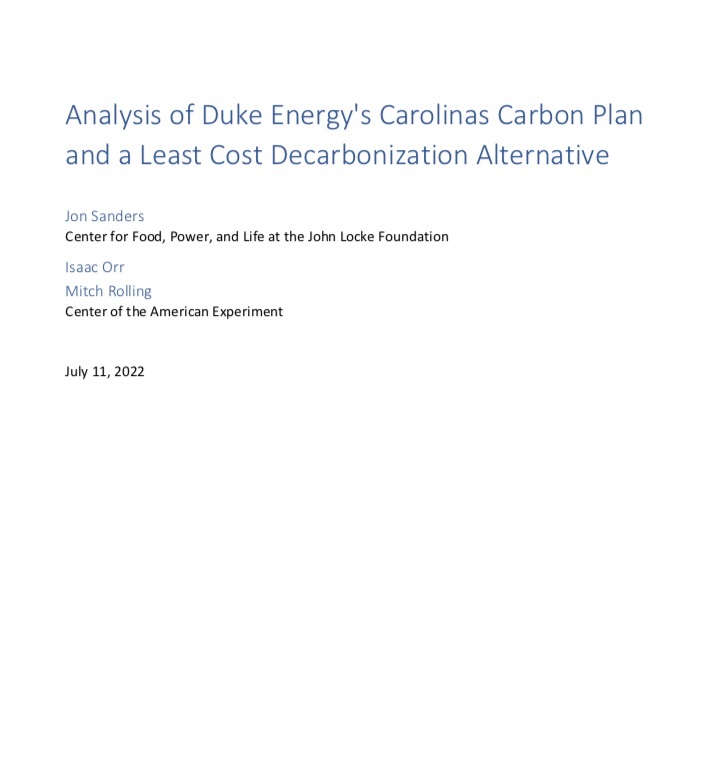On July 11, 2022, the Center for Food, Power, and Life at the John Locke Foundation filed a report with the North Carolina Utilities Commission regarding the Carolinas Carbon Plan filed with the commission by Duke Energy Progress, LLC, and Duke Energy Carolinas, LLC.
The report, “Analysis of Duke Energy’s Carolinas Carbon Plan and a Least Cost Decarbonization Alternative,” was prepared by CFPL director Jon Sanders with modeling and analysis provided by Isaac Orr and Mitch Rolling, policy fellows of the Center of the American Experiment.
Here are the main findings in brief:
- Each of the four alternate portfolios in the Duke plan would greatly increase the cost of electricity in North Carolina, greatly increase the average monthly bills of North Carolina households, compromise the reliability of the grid, and do so at an enormous cost per metric ton of CO2 reduced.
- The cost of the portfolios would range from $141.7 billion to $162.3 billion by 2050, and most of those costs would be backloaded till after 2035.
- Residential bills by 2050 would have increased between $86 to $95 per month, and commercial and industrial bills would see great increases as well.
- Hourly load estimates during a model week in August found capacity shortfalls of 31 to 41 hours, which could be significant enough to trigger load-shedding.
- The average cost of CO2 reduced would range from $246 to $259 per metric ton, which would be several times higher than even the Obama administration’s questionable estimates of the Social Cost of Carbon.
- The portfolios would each require an enormous increase in the amount of installed capacity in North Carolina, ranging from 84.3 percent to 92.3 percent (while total state population is expected to increase by only 32 percent). Each of the portfolios in Duke’s Carolinas Carbon Plan not only expects the state’s installed capacity to get much larger and more expensive, but also much less efficient as well.
- The portfolios need to overbuild renewable resources to try to counterbalance their unreliability and intermittence, resulting in the property-tax expenses passed on to ratepayers increasing by $11.4 billion to $12.5 billion.
- An alternative scenario modeled in the report, the Least Cost Decarbonization (LCD) scenario, is lower-cost and more reliable than any of Duke’s carbon plans and relies on technology that is more established, showing that none of Duke’s plans would be the least-cost means of providing reliable electricity to North Carolina residents, as required by law.
Below is the Executive Summary of the report. Click the link or the pdf for the full report.
Executive Summary
North Carolina law concerning electricity provision calls for “adequate, reliable and economical utility service to all of the citizens and residents of the State” and, just as important, “the least cost mix of generation and demand-reduction measures which is achievable.” The reason for these consumer protection measures is spelled out: “the rates, services and operations of public utilities … are affected with the public interest,” and going further, “the availability of an adequate and reliable supply of electric power and natural gas to the people, economy and government of North Carolina is a matter of public policy.”
Pursuant to House Bill (HB) 951 passed on October 13, 2021, Duke Energy Progress, LLC and Duke Energy Carolinas, LLC (jointly, “Duke Energy” or “Duke”) filed its Carolinas Carbon Plan with the North Carolina Utilities Commission. The Duke Carbon Plans include four alternative scenarios for reducing carbon dioxide (CO2) emissions.
As a longtime advocate for North Carolinians, their families, and their communities, Locke recognizes electricity as a basic human necessity, the provision of which affects everyone. In recent reports we have sought to educate policymakers and the public in critical policy discussions surrounding electricity policy. We have shown there is anenormous range among energy sources not just in terms of CO2 emissions, but more vitally in terms of cost and reliability. As demonstrated by our recent “Energy Crossroads” and “Big Blow” reports, decisions made by the Commission regarding North Carolina’s future generation mix affect North Carolina families, local employers, schools, and industries deeply.
Given the critical importance of electricity provision to North Carolina families, local employers, schools, and industries, the Center for Food, Power, and Life at the John Locke Foundation reached out to energy analysts at the Center of the American Experiment for critical analysis of the costs and implications of each of the Duke plans. This report contains the results of that analysis, conducted by Isaac Orr and Mitch Rolling.
Our analysis models the cost and reliability implications for Duke’s four carbon reduction plans and provides an alternative scenario, the Least Cost Decarbonization (LCD) scenario, that is lower-cost and more reliable than any of Duke’s carbon plans and relies on technology that is more established. It concludes that none of Duke’s plans are the least-cost means of providing reliable electricity to North Carolina residents.
The main takeaway is this: North Carolinians can either have a least-cost, reliable electric grid or reduce carbon dioxide emissions. They cannot have both.
What Is HB 951?
HB 951 establishes three primary requirements, all of which must be satisfied in the plan developed by the North Carolina Utilities Commission to achieve the targeted carbon dioxide (CO2) reductions. The first requirement is that the Commission must comply with current law and practice with respect to least-cost planning for generation. The second requirement is that any generation and resource changes must maintain or improve upon the adequacy and reliability of the existing grid.
The third requirement is that any new generation facilities or other resources selected by the Commission in order to achieve the CO2 emissions reduction goals for electric public utilities must be owned and recovered on a cost-of-service basis by the applicable electric public utility, except in the case of energy efficiency measures and demand-side management, for which existing law applies, and in the case of solar generation, which is to be allocated according to the specified percentages.
Section 1 of HB 951 directs the Commission to take all reasonable steps to achieve two emissions reductions targets: (1) a 70 percent reduction in CO2 emissions from electric generating facilities owned or operated by electric public utilities in North Carolina by 2030 from 2005 levels and (2) carbon neutrality by 2050. It further provides that the timing of achievement of the interim 70 percent reduction target may be adjusted based upon certain factors.
Primary Findings
The main conclusion of our analysis is that none of the four carbon plans created by Duke Energy appear ready for prime time. Each would rely heavily upon investments in variable renewable energy (VREs) to meet HB 951 requirements to reduce CO2 emissions by 70 percent, relative to 2005 levels, by 2030, and speculative technologies that have not proved they can scale at a reasonable cost thereafter.
Each of the scenarios studied, including the LCD scenario, would cost over $100 billion through 2050 and increase the cost of electricity by at least $170 per customer per month by 2050. Given the magnitude of the costs, these carbon plans deserve a thorough vetting by the public and the state legislature to ensure North Carolinians are willing to pay the costs associated with meeting the goals established in HB 951.
Carbon Plans Are Highly Dependent on Hydrogen Assumptions
It is important to note that in order to achieve 100 percent carbon neutrality by 2050, each scenario in Duke’s Carbon Reduction Plan would rely heavily on the use of hydrogen fuel at new and some existing natural gas units, which constitute between 8,800 MW–9,900 MW of capacity, depending on the scenario.
The primary shortcoming of this strategy is Duke’s fuel-cost assumptions for hydrogen, which are substantially lower than current costs. Duke assumes a cost of $1 per kilogram (kg) of so-called green hydrogen, which is made using carbon-free electricity. $1/kg translates to a fuel cost of $7.40 per million Btu (MMBtu).
These cost assumptions were based on the Department of Energy (“DOE”) price target for clean hydrogen and are not a reflection of current costs for hydrogen fuel produced using the methods outlined by DOE. Currently, hydrogen from renewable energy costs about $5/kg, which translates to a fuel cost of $37/MMBtu.
Duke also notes the uncertainties surrounding whether there will be an adequate supply of hydrogen fuel for these facilities, as powering these facilities with green hydrogen would necessitate the construction of an entirely new supply chain. As a result, Duke’s heavy reliance on hydrogen to achieve carbon neutrality is highly speculative.
Conclusion
Each of the scenarios discussed would cause substantial increases in electricity costs for North Carolina families and businesses, but a portfolio that focuses on building reliable, dispatchable power plants would decarbonize at the lowest possible cost.
Furthermore, nuclear power plants, which can last for up to 80 years, would provide lower-cost electricity in the future as they depreciate and repay initial capital costs. That is not the case for wind and solar assets that only last 20 and 25 years, respectively. They would necessitate a constant “build and rebuild” treadmill of capital expenditures that virtually guarantee ratepayers never have low-cost electricity after capital costs are recouped.
Duke’s Carbon Plans are predicated on large capital expenditures for wind and solar and rely on optimistic hydrogen cost assumptions that are not reflective of the current state of the technology. For this reason, more study is needed by stakeholders through a thorough public information process.



